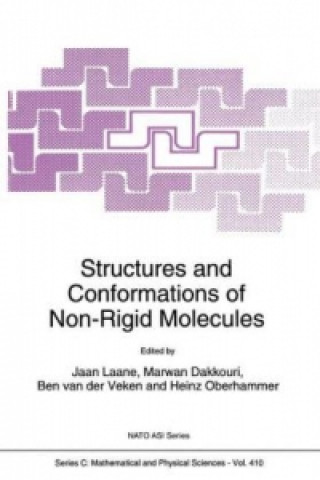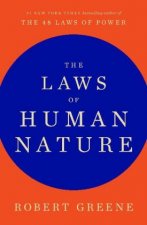
Code: 01394137
Structures and Conformations of Non-Rigid Molecules
by J. Laane, Marwan Dakkouri, Ben van der Veken
From the beginnings of modern chemistry, molecular structure has been a lively area of research and speculation. For more than half a century spectroscopy and other methods have been available to characterize the structures and sh ... more
- Language:
 English
English - Binding: Hardback
- Number of pages: 646
Publisher: Springer Netherlands, 1993
- More about this

You might also like
-

Neuroscience of Creativity
37.51 € -17 % -

Inside Out Advanced Grammar Companion
10.67 € -

Personality and Psychological Disorders
53.99 € -

Michael Caine: 1960s
40.97 € -

Material Behavior and Physical Chemistry in Liquid Metal Systems
174.99 € -

Magic, Science, Technology and Literature
30.80 € -5 %
Give this book as a present today
- Order book and choose Gift Order.
- We will send you book gift voucher at once. You can give it out to anyone.
- Book will be send to donee, nothing more to care about.
More about Structures and Conformations of Non-Rigid Molecules
You get 279 loyalty points
 Book synopsis
Book synopsis
From the beginnings of modern chemistry, molecular structure has been a lively area of research and speculation. For more than half a century spectroscopy and other methods have been available to characterize the structures and shapes of molecules, particularly those that are rigid. However, most molecules are at least to some degree non-rigid and this non-rigidity plays an important role in such diverse areas as biological activity, energy transfer, and chemical reactivity. In addition, the large-amplitude vibrations present in non-rigid molecules give rise to unusual low-energy vibrational level patterns which have a dramatic effect on the thermodynamic properties of these systems. Only in recent years has a coherent picture of the energetics and dynamics of the conformational changes inherent in non-rigid (and semi-rigid) molecules begun to emerge. Advances have been made in a number of different experimental areas: vibrational (infrared and Raman) spectroscopy, rotational (microwave) spectroscopy, electron diffraction, and, most recently, laser techniques probing both the ground and excited electronic states. Theoretically, the proliferation of powerful computers coupled with scientific insight has allowed both empirical and ab initio methods to increase our understanding of the forces responsible for the structures and energies of non-rigid systems. The development of theory (group theoretical methods and potential energy surfaces) to understand the unique characteristics of the spectra of these floppy molecules has also been necessary to reach our present level of understanding.§The thirty chapters in this volume contributed by the key speakers at the Workshop are divided over the various areas. Both vibrational and rotational spectroscopy have been effective at determining the potential energy surfaces for non-rigid molecules, often in a complementary manner. Recent laser fluorescence work has extended these types of studies to electronic excited states. Electronic diffraction methods provide radial distribution functions from which both molecular structures and compositions of conformational mixtures can be found. Ab initio calculations have progressed substantially over the past few years, and, when carried out at a sufficiently high level, can accurately reproduce (or predict ahead of time) experimental findings. Much of the controversy of the ARW related to the question of when an ab initio is reliable. Since the computer programs are readily available, many poor calculations have been carried out. However, excellent results can be obtained from computations when properly done. A similar situation exists for experimental analyses. The complexities of non-rigid molecules are many, but major strides have been taken to understand their structures and conformational processes.
 Book details
Book details
111.95 €
- Full title: Structures and Conformations of Non-Rigid Molecules
- Author: J. Laane, Marwan Dakkouri, Ben van der Veken
- Language:
 English
English - Binding: Hardback
- Number of pages: 646
- EAN: 9780792324157
- ID: 01394137
- Publisher: Springer Netherlands
- Weight: 1295 g
- Dimensions: 240 × 160 × 41 mm
- Published: 1993
Trending among others
-

Berserk Deluxe Volume 1
48.50 € -28 % -

Haunting Adeline
30.60 € -

Berserk Deluxe Volume 2
51.95 € -

Cry Baby Coloring Book
9.75 € -13 % -

Berserk Deluxe Volume 3
48.60 € -4 % -

Hunting Adeline
31.61 € -

The Official Stardew Valley Cookbook
23.58 € -18 % -

Atomic Habits
16.36 € -29 % -

Powerless
11.89 € -8 % -

Harry Potter and the Prisoner of Azkaban (Minalima Edition)
35.17 € -14 % -

Berserk Deluxe Volume 4
46.36 € -8 % -

Chainsaw Man, Vol. 15
10.36 € -23 % -

White Nights
3.55 € -

Gravity Falls Journal 3
18.29 € -14 % -

House of Leaves
23.07 € -23 % -

JUJUTSU KAISEN V22
10.67 € -18 % -

Dungeons & Dragons Essentials Kit (D&d Boxed Set)
30.19 € -

Iron Flame
16.16 € -25 % -

No Longer Human
13.41 € -17 % -

A Little Life
17.38 € -

Surrounded by Idiots
10.67 € -11 % -

Berserk Deluxe Volume 5
50.22 € -1 % -

Twisted Love
9.75 € -18 % -

Fourth Wing
10.16 € -15 % -

Don't Believe Everything You Think
13.21 € -18 % -

Bungo Stray Dogs, Vol. 8 (light novel)
16.46 € -

BALLAD OF SWORD & WINE QIANG JIN JIU V01
16.56 € -21 % -

Twisted Lies
9.75 € -18 % -

The 48 Laws of Power
24.40 € -10 % -

Twisted Games
9.75 € -24 % -

Reckless
11.79 € -18 % -

Court of Thorns and Roses Paperback Box Set (5 books)
49.82 € -21 % -

Court of Thorns and Roses
9.24 € -22 % -

Berserk Deluxe Volume 6
50.83 € -

Heaven Official's Blessing: Tian Guan Ci Fu (Novel) Vol. 1
17.99 € -15 % -

The Creative Act
23.89 € -13 % -

New Happy
17.28 € -39 % -

Icebreaker
9.14 € -23 % -

Dune Messiah
8.94 € -21 % -

Court of Mist and Fury
9.34 € -19 % -

Harry Potter and the Chamber of Secrets: MinaLima Edition
29.89 € -17 % -

Vagabond (VIZBIG Edition), Vol. 2
26.23 € -7 % -

Heaven Official's Blessing: Tian Guan Ci Fu Vol. 4
18.60 € -12 % -

Twisted Hate
10.16 € -15 % -

The Laws of Human Nature
15.95 € -5 % -

Heaven Official's Blessing: Tian Guan Ci Fu (Novel) Vol. 2
18.80 € -11 % -

Berserk Deluxe Volume 7
47.78 € -5 % -

Little Mushroom: Judgment Day
17.18 € -18 % -

CHAINSAW MAN V14
11.18 €
Collection points Bratislava a 2642 dalších
Copyright ©2008-24 najlacnejsie-knihy.sk All rights reservedPrivacyCookies



 15549 collection points
15549 collection points Delivery 2.99 €
Delivery 2.99 € 02/210 210 99 (8-15.30h)
02/210 210 99 (8-15.30h)